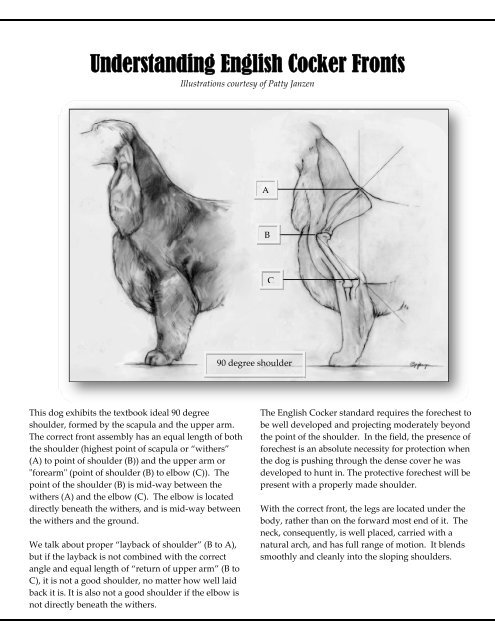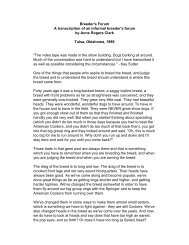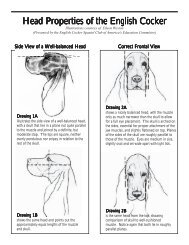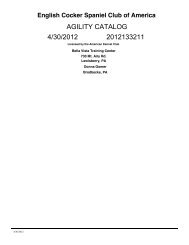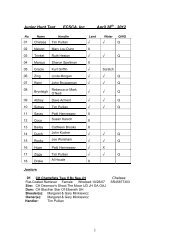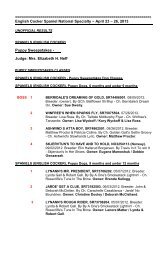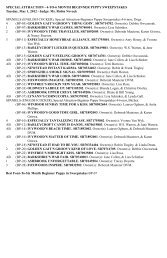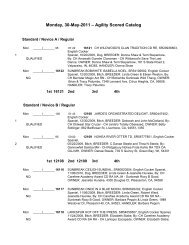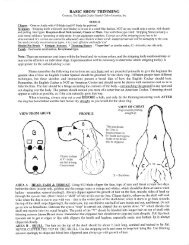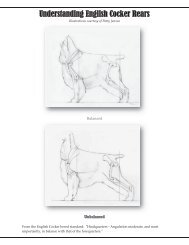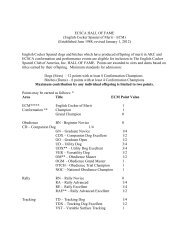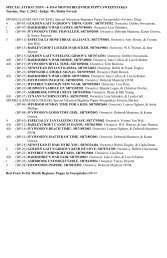Understanding the Front Assembly - English Cocker Spaniel Club of ...
Understanding the Front Assembly - English Cocker Spaniel Club of ...
Understanding the Front Assembly - English Cocker Spaniel Club of ...
Create successful ePaper yourself
Turn your PDF publications into a flip-book with our unique Google optimized e-Paper software.
<strong>Understanding</strong> <strong>English</strong> <strong>Cocker</strong> <strong>Front</strong>s<br />
Illustrations courtesy <strong>of</strong> Patty Janzen<br />
This dog exhibits <strong>the</strong> textbook ideal 90 degree<br />
shoulder, formed by <strong>the</strong> scapula and <strong>the</strong> upper arm.<br />
The correct front assembly has an equal length <strong>of</strong> both<br />
<strong>the</strong> shoulder (highest point <strong>of</strong> scapula or “wi<strong>the</strong>rs”<br />
(A) to point <strong>of</strong> shoulder (B)) and <strong>the</strong> upper arm or<br />
ʺforearmʺ (point <strong>of</strong> shoulder (B) to elbow (C)). The<br />
point <strong>of</strong> <strong>the</strong> shoulder (B) is mid‐way between <strong>the</strong><br />
wi<strong>the</strong>rs (A) and <strong>the</strong> elbow (C). The elbow is located<br />
directly beneath <strong>the</strong> wi<strong>the</strong>rs, and is mid‐way between<br />
<strong>the</strong> wi<strong>the</strong>rs and <strong>the</strong> ground.<br />
We talk about proper “layback <strong>of</strong> shoulder” (B to A),<br />
but if <strong>the</strong> layback is not combined with <strong>the</strong> correct<br />
angle and equal length <strong>of</strong> “return <strong>of</strong> upper arm” (B to<br />
C), it is not a good shoulder, no matter how well laid<br />
back it is. It is also not a good shoulder if <strong>the</strong> elbow is<br />
not directly beneath <strong>the</strong> wi<strong>the</strong>rs.<br />
A<br />
B<br />
C<br />
90 degree shoulder<br />
The <strong>English</strong> <strong>Cocker</strong> standard requires <strong>the</strong> forechest to<br />
be well developed and projecting moderately beyond<br />
<strong>the</strong> point <strong>of</strong> <strong>the</strong> shoulder. In <strong>the</strong> field, <strong>the</strong> presence <strong>of</strong><br />
forechest is an absolute necessity for protection when<br />
<strong>the</strong> dog is pushing through <strong>the</strong> dense cover he was<br />
developed to hunt in. The protective forechest will be<br />
present with a properly made shoulder.<br />
With <strong>the</strong> correct front, <strong>the</strong> legs are located under <strong>the</strong><br />
body, ra<strong>the</strong>r than on <strong>the</strong> forward most end <strong>of</strong> it. The<br />
neck, consequently, is well placed, carried with a<br />
natural arch, and has full range <strong>of</strong> motion. It blends<br />
smoothly and cleanly into <strong>the</strong> sloping shoulders.
100 degree<br />
shoulder<br />
The standard calls for moderate and<br />
equal angulation front and rear, so<br />
realistically we look for about 100 degree<br />
shoulder angulation. The forechest is still<br />
present and protective, although less so<br />
than with a 90 degree shoulder.<br />
To evaluate a front, locate <strong>the</strong> wi<strong>the</strong>rs<br />
with your right hand. Find <strong>the</strong> point <strong>of</strong><br />
<strong>the</strong> shoulder with your left middle finger<br />
and <strong>the</strong> elbow with your left thumb. Are<br />
<strong>the</strong> wi<strong>the</strong>rs directly over <strong>the</strong> elbow? Are<br />
<strong>the</strong> shoulder and upper arm equal in<br />
length? Is <strong>the</strong> angle about 100 degrees<br />
(or better), or is <strong>the</strong> angle more open?<br />
110 degree<br />
shoulder<br />
This shoulder assembly has a more open<br />
angle. When in motion, this dog will not<br />
have <strong>the</strong> reach in front <strong>of</strong> <strong>the</strong> 90 or 100<br />
degree shoulder, and consequently his<br />
movement will be less efficient. Because<br />
he does have equal lengths <strong>of</strong> shoulder<br />
and upper arm, and <strong>the</strong> elbow is directly<br />
below <strong>the</strong> wi<strong>the</strong>rs, this shoulder could be<br />
considered to be on <strong>the</strong> very lower end <strong>of</strong><br />
acceptable. Notice <strong>the</strong> lack <strong>of</strong> prominent<br />
forechest because <strong>of</strong> <strong>the</strong> more open angle.<br />
The neck is more upright and doesn’t<br />
blend as cleanly into <strong>the</strong> shoulders.
Tipped<br />
forward<br />
This shoulder is tipped forward, instead <strong>of</strong><br />
being laid back towards <strong>the</strong> rear <strong>of</strong> <strong>the</strong> dog.<br />
It places <strong>the</strong> wi<strong>the</strong>rs well forward <strong>of</strong> <strong>the</strong><br />
elbow. When in motion, <strong>the</strong> dog will look<br />
as if he is falling over his front, which is<br />
exactly how he is made to move. Due to <strong>the</strong><br />
incorrect placement <strong>of</strong> <strong>the</strong> scapula, <strong>the</strong> neck<br />
juts forward and is very restricted in its<br />
range <strong>of</strong> motion, a true detriment in <strong>the</strong><br />
field.
Straight front, over<br />
angulated rear<br />
Here is a moderately upright shoulder with a short, practically vertical upper arm. There is no<br />
return <strong>of</strong> upper arm as <strong>the</strong> elbow is not directly under <strong>the</strong> wi<strong>the</strong>rs. The front is set on <strong>the</strong><br />
forward most part <strong>of</strong> <strong>the</strong> dog and <strong>the</strong> protective forechest is non‐existent.<br />
The neck is upright, going into <strong>the</strong> shoulders at a right angle, is weak, and ewed. This straight<br />
shouldered dog would have difficulty reaching down to pick up a bird, and <strong>the</strong> weight <strong>of</strong> <strong>the</strong><br />
bird would put a strain on his weak neck. He will move with a hackney action and with very<br />
little reach in front.<br />
This particular shoulder assembly, combined with an overangulated rear, as shown here, is <strong>the</strong><br />
most common structural problem found in <strong>the</strong> <strong>English</strong> <strong>Cocker</strong> ring today.
The refined, straight‐fronted dog on <strong>the</strong> left exhibits a pinched, hollow, ʺca<strong>the</strong>dralʺ front. He<br />
has no protective ʺfillʺ (forechest and body) in front because his short, upright upper arm places<br />
his front forward <strong>of</strong> his body (see previous illustration). His body is hung back, behind his<br />
front. He is narrow throughout, with no apparent spring <strong>of</strong> rib. His lack <strong>of</strong> bone fits his overall<br />
ʺsetteryʺ make and shape.<br />
On <strong>the</strong> right is a dog with correct shoulder construction. His forechest and body fill in his front,<br />
as his front legs are located well underneath his body, due to <strong>the</strong> length and ʺreturnʺ <strong>of</strong> his<br />
upper arm. His chest is deep, <strong>the</strong> forechest is well developed, and <strong>the</strong> brisket reaches to <strong>the</strong><br />
elbow. His well sprung, deep ribbing is evident from <strong>the</strong> front. He has a generous amount <strong>of</strong><br />
bone to support his well‐made body.
ʺIn any breed, <strong>the</strong> whole dog is hung on its front end. How <strong>the</strong> neck is set, how its topline is, all<br />
go to <strong>the</strong> front.ʺ<br />
ʺMust have forechest out in front. Weʹre getting a lot <strong>of</strong> <strong>English</strong> <strong>Cocker</strong>s whose fronts drop<br />
straight down, a so‐called Terrier front where <strong>the</strong>yʹre laid back in shoulder, are short in forearm<br />
and <strong>the</strong>ir fronts are way out in front <strong>of</strong> <strong>the</strong>m with no forechest ‐ itʹs totally incorrect for a<br />
<strong>Cocker</strong>. Got to have some forechest!ʺ<br />
Anne Rogers Clark ‐ second generation <strong>English</strong> <strong>Cocker</strong><br />
breeder, E.C.S.C.A. Past President<br />
Presented by <strong>the</strong> <strong>English</strong> <strong>Cocker</strong> <strong>Spaniel</strong> <strong>Club</strong> <strong>of</strong> America’s Education Committee


